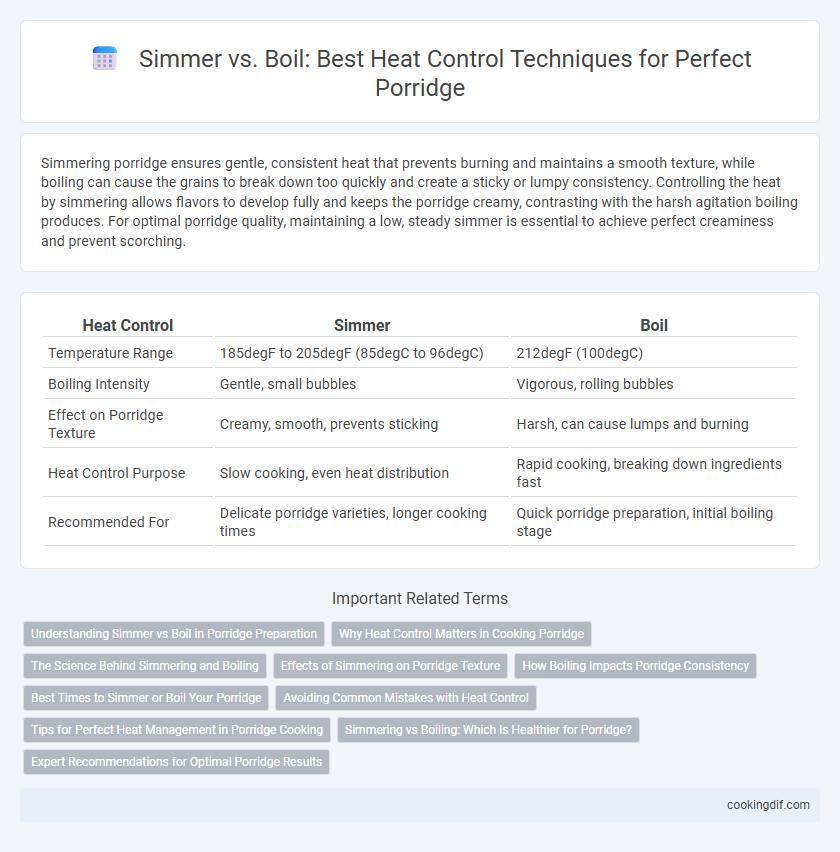Simmering porridge ensures gentle, consistent heat that prevents burning and maintains a smooth texture, while boiling can cause the grains to break down too quickly and create a sticky or lumpy consistency. Controlling the heat by simmering allows flavors to develop fully and keeps the porridge creamy, contrasting with the harsh agitation boiling produces. For optimal porridge quality, maintaining a low, steady simmer is essential to achieve perfect creaminess and prevent scorching.
Table of Comparison
| Heat Control | Simmer | Boil |
|---|---|---|
| Temperature Range | 185degF to 205degF (85degC to 96degC) | 212degF (100degC) |
| Boiling Intensity | Gentle, small bubbles | Vigorous, rolling bubbles |
| Effect on Porridge Texture | Creamy, smooth, prevents sticking | Harsh, can cause lumps and burning |
| Heat Control Purpose | Slow cooking, even heat distribution | Rapid cooking, breaking down ingredients fast |
| Recommended For | Delicate porridge varieties, longer cooking times | Quick porridge preparation, initial boiling stage |
Understanding Simmer vs Boil in Porridge Preparation
Simmering porridge maintains a gentle heat below boiling point, preventing the grains from breaking apart and ensuring a creamy texture. Boiling porridge involves higher temperatures that cause vigorous bubbles, which can lead to uneven cooking and a burnt bottom. Controlling heat by simmering allows for better absorption of liquid and consistent thickening, essential for smooth and flavorful porridge.
Why Heat Control Matters in Cooking Porridge
Heat control is essential in cooking porridge to achieve the perfect texture and prevent burning. Simmering allows slow, even cooking that softens grains and prevents sticking, while boiling can cause uneven cooking and scorching. Maintaining a gentle simmer ensures porridge retains a creamy consistency and optimal flavor development.
The Science Behind Simmering and Boiling
Simmering maintains water temperature just below boiling point, around 185-205degF (85-96degC), allowing gentle cooking that prevents starch molecules in porridge from breaking down excessively. Boiling occurs at 212degF (100degC), causing vigorous bubbles that can disrupt the porridge's texture and lead to uneven cooking or scorching. Controlling heat to simmer ensures gradual starch gelatinization and optimal creaminess by preserving the porridge's structural integrity at a molecular level.
Effects of Simmering on Porridge Texture
Simmering porridge maintains a gentle, consistent heat that allows starch granules to swell gradually, resulting in a creamier and smoother texture. Boiling can cause rapid starch breakdown and uneven cooking, often leading to a grainy or lumpy consistency. Controlled simmering enhances the porridge's softness and prevents scorching, ensuring an optimal mouthfeel.
How Boiling Impacts Porridge Consistency
Boiling porridge causes the starches to break down rapidly, leading to a thinner, less creamy consistency and increased risk of sticking or scorching at the bottom of the pot. Simmering maintains a gentle heat that allows the grains to absorb liquid evenly, resulting in a smoother, thicker texture with a richer mouthfeel. Proper heat control during simmering preserves the porridge's structure and enhances its overall flavor and creaminess.
Best Times to Simmer or Boil Your Porridge
Simmering porridge at a low heat ensures even cooking and prevents scorching, ideal for delicate grains like oats that require gentle heat over 10-15 minutes. Boiling is best for quick-cooking varieties such as cornmeal or rice porridge, where high heat speeds up the softening process in 5-7 minutes without compromising texture. Controlling heat by simmering or boiling at precise times enhances the porridge's creaminess and prevents clumping or burning.
Avoiding Common Mistakes with Heat Control
Simmering porridge at a low, steady heat prevents burning and sticking, ensuring a creamy texture, while boiling at high heat often leads to uneven cooking and scorching. Maintaining a consistent simmer allows the starches to gelatinize properly, producing a smooth, thick consistency. Avoiding the common mistake of overheating minimizes the risk of lumps and overflow, resulting in a perfectly cooked porridge.
Tips for Perfect Heat Management in Porridge Cooking
Maintaining a gentle simmer rather than a full boil is essential for perfect porridge texture and preventing scorching. Use medium-low heat to allow slow, consistent cooking, which ensures the grains absorb liquid evenly and achieve a creamy consistency. Stir frequently to prevent sticking and adjust heat to keep small bubbles forming without vigorous boiling.
Simmering vs Boiling: Which Is Healthier for Porridge?
Simmering porridge at a low, steady heat preserves essential nutrients and prevents the starches from breaking down too quickly, resulting in a creamier texture and better digestibility. Boiling, on the other hand, involves higher temperatures that can degrade vitamins like B-complex and reduce antioxidant levels. Healthier porridge is achieved through simmering, which maintains nutritional integrity while enhancing flavor and texture.
Expert Recommendations for Optimal Porridge Results
Experts recommend maintaining a gentle simmer rather than a rolling boil when cooking porridge to ensure even heat distribution and prevent scorching. Simmering allows the grains to absorb liquid gradually, resulting in a creamy texture and consistent thickness. Boiling can cause rapid evaporation and uneven cooking, leading to burnt edges and a grainy consistency.
Simmer vs Boil for heat control Infographic

 cookingdif.com
cookingdif.com